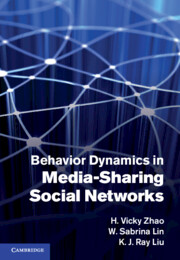Book contents
- Frontmatter
- Contents
- Preface
- Part I Introduction
- 1 Introduction to media-sharing social networks
- 2 Overview of multimedia fingerprinting
- 3 Overview of mesh-pull peer-to-peer video streaming
- 4 Game theory for social networks
- Part II Behavior forensics in media-sharing social networks
- Part III Fairness and cooperation stimulation
- Part IV Misbehaving user identification
- Part V Media-sharing social network structures
- References
- Index
3 - Overview of mesh-pull peer-to-peer video streaming
from Part I - Introduction
Published online by Cambridge University Press: 28 April 2011
- Frontmatter
- Contents
- Preface
- Part I Introduction
- 1 Introduction to media-sharing social networks
- 2 Overview of multimedia fingerprinting
- 3 Overview of mesh-pull peer-to-peer video streaming
- 4 Game theory for social networks
- Part II Behavior forensics in media-sharing social networks
- Part III Fairness and cooperation stimulation
- Part IV Misbehaving user identification
- Part V Media-sharing social network structures
- References
- Index
Summary
With recent advances in networking, multimedia signal processing, and communication technologies, we have witnessed the emergence of large-scale video streaming social networks, in which millions of users form a distributed and dynamically changing infrastructure to share video streams. Statistics showed that more than 75 percent of the total US Internet audience have viewed online video, and the average online video viewer watched four hours of video per month. With the fast deployment of high-speed residential network access, video is expected to be the dominating traffic on the Internet in the near future.
The traditional method for video streaming over the Internet is the client-server service model. A client sets up a connection with a video source server and video content is directly streamed to the client from either the video source server or a nearby content delivery server. The most popular client-server video stream service nowadays is YouTube, which drew 5 billion US video views in July 2008. However, client-server–based video streaming methods incur expensive bandwidth provision cost on the server. For example, the streaming rate for a TV-quality video is about 400 kilobits per second (kbps), which makes the client-server video streaming solution very expensive when more users join the system.
P2P video streaming encourages users to upload their downloaded data to other users in the network; each user acts as a server and a client at the same time. The system relies on voluntary contributions of resources from individual users to achieve high scalability and robustness and to provide satisfactory performance.
- Type
- Chapter
- Information
- Behavior Dynamics in Media-Sharing Social Networks , pp. 24 - 40Publisher: Cambridge University PressPrint publication year: 2011



